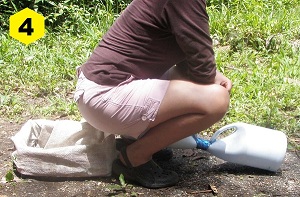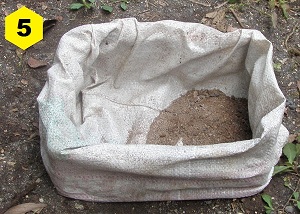A Free Minimalist Urine-diverting Dry Toilet (UDDT) for the Unhoused, Poor or Disaster-stricken
By Chris Canaday. Ecuador-based researcher Canaday generously prepared this in response to our inquiries. He invites feedback via Inodoroseco or email canaday2 AT gmail.com
Shifting from wasteful, expensive, contaminating, water-based toilets to decentralized, environmentally friendly, dry toilets should be more a matter of paradigm shift than capital investment. This is especially true for those who have little money, are potentially living on the street, or are in the upheaval of an emergency.
The key things that a UDDT needs to do are: (1) jail up the potentially dangerous feces that may transmit many terrible diseases (including diarrhea, cholera, typhoid, and intestinal worm eggs) long enough for these to die and (2) set the urine free on the soil, where it is excellent fertilizer for the plants and transmits no disease. This separation also greatly reduces the potential for stench and keeps the volume of dangerous material small and manageable.
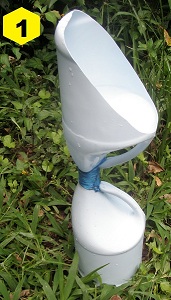 The following minimalist toilet is entirely functional and is made with just a few readily available materials that can be rescued from the garbage:
The following minimalist toilet is entirely functional and is made with just a few readily available materials that can be rescued from the garbage:
- Two 4-liter plastic bottles, like those used to sell bleach.
- 50 centimeters of tape.
- 2 meters of string.
- Four sticks, 25 centimeters long (or a box the right size).
- Some normal, woven, polypropylene sacks, like those used to sell 100 pounds of flour, rice, or whatever. Biodegradable, jute bags (like coffee sacks) can also be used and even have an advantage (see #7, below).
- A small sheet of plastic.
Instructions
(1) Make a portable, ecological urinal from the two bottles, cutting one diagonally (as shown) and joining them together mouth-to-mouth with tape and then firmly with string. This is a very useful item, even if one has a more up-scale outhouse, as it can be used for peeing next to bed in the middle of the night, without having to go out into the dark among snakes, insects, rapists or other creatures. It can also be used during the day wherever there is enough privacy.
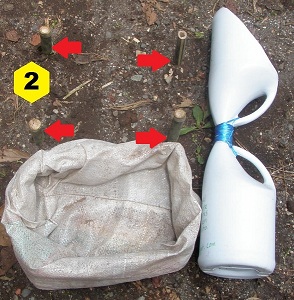 While standing with urine in it, this urinal emits very little smell, since the mouths of the bottles are small and the top bottle blocks the movement of air across these mouths. Each day, it gets rinsed with water to avoid smell developing with the fermentation of the urine.
While standing with urine in it, this urinal emits very little smell, since the mouths of the bottles are small and the top bottle blocks the movement of air across these mouths. Each day, it gets rinsed with water to avoid smell developing with the fermentation of the urine.
This costless urinal is very practical for collecting urine, diluting it with at least three times as much graywater, and pouring this excellent fertilizer on the soil among one’s crop plants … or among the ornamental plants in the city park to help them flower more beautifully. One could also dump the urine into a sewer drain, but that would waste the nutrients, increase public spending on wastewater treatment, and contribute to the formation of anoxic dead zones in rivers and oceans.
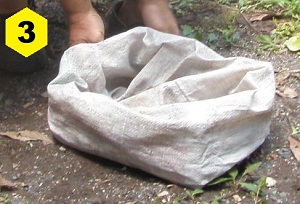 (2) Push the four sticks into the ground, to a height of about 12 centimeters. If one prefers (or especially if the floor is cement and you cannot poke sticks into the ground), a cardboard, wooden or plastic box the right size could be used instead of the sticks.
(2) Push the four sticks into the ground, to a height of about 12 centimeters. If one prefers (or especially if the floor is cement and you cannot poke sticks into the ground), a cardboard, wooden or plastic box the right size could be used instead of the sticks.
(3) Roll down the edge of the sack and place it over the sticks. Put in a cup of dry soil where the first deposit will fall.
(4) Put your heels against the sack, squat down, hold the urinal inclined in front of you, and release your load of nutrients. The feces will fall neatly into the sack, while the urine flows neatly into the urinal. Then, stand up the urinal until the next convenient opportunity to spread it on the soil. Place the paper, leaves, corn cobs or whatever was used for wiping together with the feces. (Arrange for privacy however you like, maybe with palm fronds stuck in the ground.)
(5) Put a cup of dry soil on top of the feces to cover them, control the smell, keep flies from laying their eggs, and inoculate them with beneficial decomposer soil microbes. Keep a stick in the sack to accommodate the feces and paper, facilitate them being covered adequately by the soil, and fill the space in an orderly way (always grabbing the non-sh*tty end of the stick). One of the best soils for this consists of the decomposed feces from a previous cycle, as seen here, with some sawdust mixed in if it is too compact.
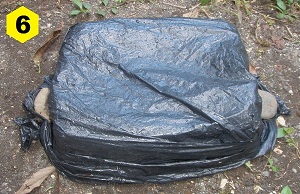 (6) When not in use, cover the whole thing tightly with a sheet of plastic to keep rain, flies and curious eyes out.
(6) When not in use, cover the whole thing tightly with a sheet of plastic to keep rain, flies and curious eyes out.
(7) When full (to a height of nearly the 12 cm), or when the users are moving on, tie the sack shut with a tag that says something like, “Open this package of rich organic soil only after XX/X/20XX (a year or two from now) when it is safe to use in agriculture” and hide it somewhere protected against the rain and sun, like under a bridge. Another option would be to bury the sack, preferably in dry, well aerated soil (potentially under that same bridge).
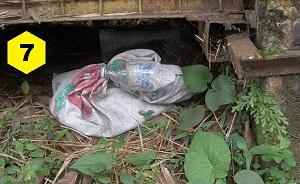 The feces should dry and decompose for at least 6 months in the Tropics or a year in Temperate Countries (longer if buried in the soil), so that the pathogens die and it is no longer dangerous.
The feces should dry and decompose for at least 6 months in the Tropics or a year in Temperate Countries (longer if buried in the soil), so that the pathogens die and it is no longer dangerous.
If the users are there long enough, or come back, they can use this new soil themselves in agriculture, or recycle it as an excellent cover material for new feces in the UDDT once again. More worrisome people might want to only put it in the bottoms of holes for planting trees, which is also a great use.
The advantage of using biodegradable, jute sacks is that one can just throw the recently filled sack in the bottom of a hole, plant a tree on top of it, and forget about it (until you wonder why the tree is growing so fast and with such luscious fruits).
Discussion
“Conventional wisdom” or fecophobia (the irrational fear of feces) may lead people to have the following doubts about this system:
Couldn’t the fecal pathogens get out through the woven cloth of the sack?
Aside from hookworm larvae, fecal pathogens do not actively move anywhere and just wait passively to get washed into someone’s drinking water, brushed onto someone’s unwashed hands before they eat, or carried by flies to someone else’s food. These are the risks of open defecation, with fecal pathogens set loose in the environment. Liquids do not flow out of these sacks, given the dry cover material we add after each use, the separation of the urine, and the protection against the rain. The permeability of the woven cloth is actually a positive thing, since this allows humidity to evaporate out and oxygen to filter in (without smell or flies coming or going), so the feces can decompose normally, with the pathogens dying off at an exponential rate. See an example of letting feces decompose in these woven sacks in this video.
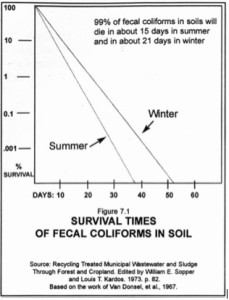
As shown in this graph from the Humanure Handbook by Joseph Jenkins, Fecal coliform bacteria die in the soil at an exponential rate.
As shown in this graph from the Humanure Handbook by Joseph Jenkins, Fecal coliform bacteria die in the soil at an exponential rate.
Getting back to the hookworm larvae, they only travel through moist sandy or loamy soil (not clay), so some sticks or stones may be placed under the sack when it is placed under that bridge, and wood ash (which is alkaline) may also be placed on, around, and under the sacks. Furthermore, hookworms are not usually life-threatening, nor are they terribly common, with “only” up to some 740 million persons infected in the world, mostly in Africa and Southeast Asia. It is reasonably easy to check if people have them (using a microscope) and to wipe them out with chemicals or with natural alternatives, such as papaya seeds. Plus we should always remember that hookworm larvae can only be in the feces if the users have these worms. Pathogens cannot come out of nowhere, and, in the case of hookworms, the biggest factor is dogs practicing open defecation and the larvae crawling into people’s feet. (If you do not know what hookworms look like, see this article in the Examiner. Hookworms do not just eat people’s food, but instead their blood. They were clearly the inspiration for the creature in the movie Alien.)
Can we be absolutely sure that all the pathogens will die and that no one could possibly ever get sick via this system?
No. Someone could come along and open the sack before it is time, without reading the tag, but any system can go wrong if not used right. What we can be sure about is that all the fecal pathogens are still alive and kicking in people’s fresh feces that might otherwise go straight into the environment. We also know that these pathogens die off at an exponential rate as feces decompose. The important thing is to keep these nasties jailed up while this is happening and every day of containment is a victory in the war against disease. Essentially all of these pathogens are anaerobes adapted to live in the absence of oxygen, in the aqueous habitat inside our guts, and there is only a certain amount of time they can hang on in a dry, oxygenated substrate before infecting the next person. Given this situation, the most persistent fecal pathogens have evolved desiccation-resistant packaging, like the amoebic cyst and the shell of the Ascaris egg, but even these can only protect them for a certain amount of time.
A key factor is the rambunctious and relentless nature of the microbes in rich organic soil, eating everything that does not eat them first. Most pathogenic microbes would be easy prey to soil organisms and it has been shown that fecal bacteria die-off faster in species-rich soil, as I recommend using here, optimally with the reuse of finished compost as cover material, with exactly the microbes that broke down the feces of the previous cycle, and which are not human pathogens.
Schönning and Stenström (2004) recommend storing the feces, with an ample amount of wood ash or mineral lime for over 2 years in the Temperate Zone and 1 year in the Tropics. Personally, I think this is overcautious, especially in the biodiverse, warm Tropics, but these detention times can easily be applied if there is enough space and it makes people feel more comfortable. These times refer to the most persistent fecal pathogens, which are the eggs of the Ascaris Giant Roundworm, and all the really dangerous microbial pathogens are wiped out in less than three months. We have done trials to look for Ascaris eggs in our fecal compost, here in Amazonian Ecuador, and have yet to find any beyond four months of decomposition. More trials need to be done and a simpler, more conclusive protocol that mostly only requires a microscope needs to be developed. And even I store the feces for over a year, for more peace of mind of all the users.
No one wants to go on record recommending a detention time that may potentially allow someone to get sick, and this is especially the case with governmental and international organizations. I am nonetheless willing to go out on this limb, given that the worst alternative is to continue with the currently abundant cases of open defecation, raw sewage going straight into so many rivers and bays, and 2.6 billion people in the world that do not have any sort of decent toilet. And, if over time, we find that we should modify these suggested detention times (longer or shorter), we can do so.
Aren’t we supposed to store urine for a number of months to sanitize it before applying it on the soil?
This concern is due to the possibility that feces may have contaminated the urine through people using the UDDTs improperly or having accidents … and this is very unlikely with this “bare bones UDDT”, in which the user holds the urinal right where it needs to be. If an accident were to happen, the user could dump the urine in a hole in the ground and cover it up, instead of spreading it on the surface of the soil. In places where there is the Bilharzia parasite, Schistosoma haematobium, urine should be spread on the soil far from lakes and rivers, so that this parasite cannot get to the freshwater snails it needs to infect in order to continue its life cycle.
Won’t some animal, like a dog or a rat, tear open the sack and spread this dangerous material around?
Experience has shown that they do not, especially if we are using soil as a cover material, in particular that special recycled soil. There have been a couple of cases of mischievous dogs, but only when pure sawdust was being used as the cover material. Soil and finished compost are also among the best filters for odors.
Fecophobia aside, other important questions can arise:
Why should we protect the sacks from the sun? Wouldn’t the solar rays help to kill the pathogens?

A graph showing the time necessary for various human fecal pathogens to die at different temperatures, from Feachem, R.G., Bradley, D.J., Garelick, H. and Mara, D.D. 1983. Sanitation and Disease – Health aspects of excreta and waste water management. John Wiley and Sons, Chichester, UK (as cited in Schönning and Stenström 2004). For example, all pathogens die within one hour at 65° C, or within a month at 45° C.
Yes, they would, but the ultraviolet light also destroys the polypropylene plastic strands of the sacks. Solar ovens that take this into account would be a good idea (and we can be much more patient about baking feces for sanitation than about baking lunch for our urgent hunger). According to the following graph, we only need to achieve 65°C for an hour to kill all of the fecal pathogens, and this is much easier than the 100°C required to boil water. One time, a student and I made a simple solar oven from recycled materials, and we apparently got to above 80° C, because the PET plastic Coke bottle got deformed and the Ascaris eggs held within were also seen under the microscope to be deformed and almost certainly dead.
A graph showing the time necessary for various human fecal pathogens to die at different temperatures, from Feachem, R.G., Bradley, D.J., Garelick, H. and Mara, D.D. 1983. Sanitation and Disease – Health aspects of excreta and waste water management. John Wiley and Sons, Chichester, UK (as cited in Schönning and Stenström 2004). For example, all pathogens die within one hour at 65° C, or within a month at 45° C.
What if we aren’t quite so broke and want something nicer?
You can do it. If your soil is fairly dry and absorbent and never gets flooded, think about making an ArborLoo, which is a lightweight outhouse that gets placed on one and another one-meter-deep holes where trees later get planted, like this one we made from mostly recycled materials. Remember to add a cup of soil, dry leaves or ashes with each use. If you do not have room to plant an infinite number of trees, you can plant vegetables, like pumpkins, and dig a new hole in the same spot after at least two years.
Also, check out the Simple UDDTs I published in Sustainable Sanitation Practice and various other models on my blog, some of which have beautiful ceramic floors set into thin ferrocement that only needs a half a sack of cement. And set up a TippyTap to wash your hands.
Author’s Note: If you have any questions or suggestions about this simple toilet, please let me know. I also invite you to read more about the current problems of sanitation in this interview and more about Urine-diverting Dry Toilets in this interview.

